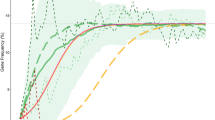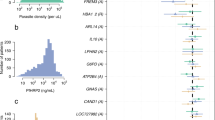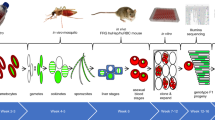Abstract
Previously, we have shown that pyruvate kinase, liver and red cell isoform (PKLR) deficiency protects mice in vivo against blood-stage malaria, and observed that reduced PKLR function protects human erythrocytes against Plasmodium falciparum replication ex vivo. Here, we have sequenced the human PKLR gene in 387 individuals from malaria-endemic and other regions in order to assess genetic variability in different geographical regions and ethnic groups. Rich genetic diversity was detected in PKLR, including 59 single-nucleotide polymorphisms and several loss-of-function variants (frequency 1.5%). Haplotype distribution and allele frequency varied considerably with geography. Neutrality testing suggested positive selection of the genein the sub-Saharan African and Pakistan populations. It is possible that such positive selection involves the malarial parasite.
This is a preview of subscription content, access via your institution
Access options
Subscribe to this journal
Receive 6 digital issues and online access to articles
$119.00 per year
only $19.83 per issue
Buy this article
- Purchase on Springer Link
- Instant access to full article PDF
Prices may be subject to local taxes which are calculated during checkout


Similar content being viewed by others
References
University Medical Center. PKLR Mutation Database. Laboratory for Red Blood Cell Research: Utrecht, 2007.
Valentini G, Chiarelli LR, Fortin R, Dolzan M, Galizzi A, Abraham DJ et al. Structure and function of human erythrocyte pyruvate kinase. molecular basis of nonspherocytic hemolytic anemia. J Biol Chem 2002; 277: 23807–23814.
van Wijk R, Huizinga EG, van Wesel AC, van Oirschot BA, Hadders MA, van Solinge WW . Fifteen novel mutations in PKLR associated with pyruvate kinase (PK) deficiency: structural implications of amino acid substitutions in PK. Hum Mutat 2009; 30: 446–453.
Min-Oo G, Fortin A, Tam MF, Nantel A, Stevenson MM, Gros P . Pyruvate kinase deficiency in mice protects against malaria. Nat Genet 2003; 35: 357–362.
Ayi K, Min-Oo G, Serghides L, Crockett M, Kirby-Allen M, Quirt I et al. Pyruvate kinase deficiency and malaria. N Engl J Med 2008; 358: 1805–1810.
Ayi K, Liles WC, Gros P, Kain KC . Adenosine triphosphate depletion of erythrocytes simulates the phenotype associated with pyruvate kinase deficiency and confers protection against Plasmodium falciparum in vitro. J Infect Dis 2009; 200: 1289–1299.
Machado P, Pereira R, Rocha AM, Manco L, Fernandes N, Miranda J et al. Malaria: looking for selection signatures in the human PKLR gene region. Br J Haematol 2010; 149: 775–784.
Browning SR, Browning BL . Rapid and accurate haplotype phasing and missing-data inference for whole-genome association studies by use of localized haplotype clustering. Am J Hum Genet 2007; 81: 1084–1097.
Sabeti PC, Reich DE, Higgins JM, Levine HZ, Richter DJ, Schaffner SF et al. Detecting recent positive selection in the human genome from haplotype structure. Nature 2002; 419: 832–837.
Rosenberg NA . Standardized subsets of the HGDP-CEPH Human Genome Diversity Cell Line Panel, accounting for atypical and duplicated samples and pairs of close relatives. Ann Hum Genet 2006; 70 (Part 6): 841–847.
Leutenegger AL, Sahbatou M, Gazal S, Cann H, Genin E . Consanguinity around the world: what do the genomic data of the HGDP-CEPH diversity panel tell us? Eur J Hum Genet 2011; 19: 583–587.
Shi W, Ayub Q, Vermeulen M, Shao RG, Zuniga S, van der Gaag K et al. A worldwide survey of human male demographic history based on Y-SNP and Y-STR data from the HGDP-CEPH populations. Mol Biol Evol 2010; 27: 385–393.
Beutler E, Gelbart T . Estimating the prevalence of pyruvate kinase deficiency from the gene frequency in the general white population. Blood 2000; 95: 3585–3588.
Demina A, Varughese KI, Barbot J, Forman L, Beutler E . Six previously undescribed pyruvate kinase mutations causing enzyme deficiency. Blood 1998; 92: 647–652.
Abu-Melha AM, Ahmed MA, Knox-Macaulay H, Al-Sowayan SA, el-Yahia A . Erythrocyte pyruvate kinase deficiency in newborns of eastern Saudi Arabia. Acta Haematol 1991; 85: 192–194.
Feng CS, Tsang SS, Mak YT . Prevalence of pyruvate kinase deficiency among the Chinese: determination by the quantitative assay. Am J Hematol 1993; 43: 271–273.
Yavarian M, Karimi M, Shahriary M, Afrasiabi AR . Prevalence of pyruvate kinase deficiency among the south Iranian population: quantitative assay and molecular analysis. Blood Cells Mol Dis 2008; 40: 308–311.
Librado P, Rozas J . DnaSP v5: a software for comprehensive analysis of DNA polymorphism data. Bioinformatics 2009; 25: 1451–1452.
Akey JM, Eberle MA, Rieder MJ, Carlson CS, Shriver MD, Nickerson DA et al. Population history and natural selection shape patterns of genetic variation in 132 genes. PLoS Biol 2004; 2: e286.
Wayne ML, Simonsen KL . Statistical tests of neutrality in the age of weak selection. Trends Ecol Evol 1998; 13: 236–240.
Schaffner SF, Foo C, Gabriel S, Reich D, Daly MJ, Altshuler D . Calibrating a coalescent simulation of human genome sequence variation. Genome Res 2005; 15: 1576–1583.
Zhang L, Peek AS, Dunams D, Gaut BS . Population genetics of duplicated disease-defense genes, hm1 and hm2, in maize (Zea mays ssp. mays L.) and its wild ancestor (Zea mays ssp. parviglumis). Genetics 2002; 162: 851–860.
Mirabello L, Conn JE . Molecular population genetics of the malaria vector Anopheles darlingi in Central and South America. Heredity 2006; 96: 311–321.
Cann HM, de Toma C, Cazes L, Legrand MF, Morel V, Piouffre L et al. A human genome diversity cell line panel. Science 2002; 296: 261–262.
Barrett JC, Fry B, Maller J, Daly MJ . Haploview: analysis and visualization of LD and haplotype maps. Bioinformatics 2005; 21: 263–265.
Gabriel SB, Schaffner SF, Nguyen H, Moore JM, Roy J, Blumenstiel B et al. The structure of haplotype blocks in the human genome. Science 2002; 296: 2225–2229.
Acknowledgements
This study was funded by a Canadian Institutes of Health Research (CIHR) Team Grant in Malaria (KCK, PG), CIHR MOP-13721 (KCK), Genome Canada through the Ontario Genomics Institute (KCK), CIHR Canada Research Chairs (KCK) and CIHR studentships (JB, SH).
Author information
Authors and Affiliations
Corresponding author
Ethics declarations
Competing interests
The authors declare no conflict of interest.
Additional information
Supplementary Information accompanies the paper on Genes and Immunity website
Rights and permissions
About this article
Cite this article
Berghout, J., Higgins, S., Loucoubar, C. et al. Genetic diversity in human erythrocyte pyruvate kinase. Genes Immun 13, 98–102 (2012). https://doi.org/10.1038/gene.2011.54
Received:
Revised:
Accepted:
Published:
Issue Date:
DOI: https://doi.org/10.1038/gene.2011.54
Keywords
This article is cited by
-
A novel homozygous missense variant p.D339N in the PKLR gene correlates with pyruvate kinase deficiency in a Pakistani family: a case report
Journal of Medical Case Reports (2022)



